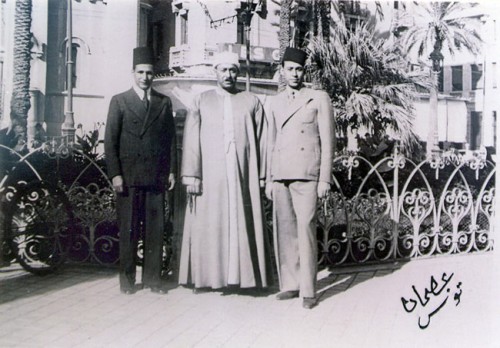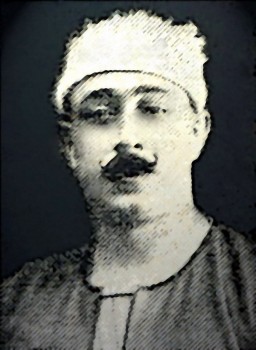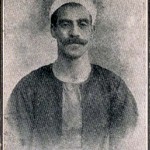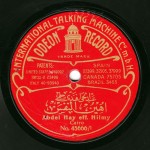The Arab Music Archiving and Research foundation (AMAR), in collaboration with the Sharjah Art Foundation (SAF), presents “Sama‘ ”.
“Sama‘ ” discusses our musical heritage through comparison and analysis…
A concept by Mustafa Said.
Dear listeners,
Welcome to a new episode of “Sama‘ ”.
Today, we will resume our analysis of dawr “Ahīn el-nafs wa-etdhallal ilēkum” written by Muḥammad al-Darwīsh and composed by Aḥmad Abū Ghunayma to the maqām ḥiṣār.
We had stopped in our previous episode at the dawr following the madhhab “Alū-lī el-nās ‘ala awṣāf gamālak”, after mentioning that originally in the dawr, the same phrase of the madhhab was repeated with new lyrics, replacing “Ahīn el-nafs wa-etdhallal ilēkum” with “Alū-lī el-nās ‘ala awṣāf gamālak”. Whereas Amīn Ḥasanayn and Sayyid Shaṭā did not do this and ascended to the jawāb.
Let us listen to the tafrīd at “Alū-lī el-nās ‘ala awṣāf gamālak” interpreted by ‘Abd al-Ḥayy Ḥilmī and by Sulaymān Ḥasan and the mizmār –not a surprise anymore, though–, then by Amīn Ḥasanayn and Sayyid Shaṭā…
(♩)
Sulaymān Ḥasan had apparently heard ‘Abd al-Ḥayy’s recording made by Gramophone or Zonophone –the Italian Gramophone. By the way, we should discuss in one of our episodes, why there are three different matrixes, one by Zonophone, one by Gramophone, and one by His Master’s Voice of the same jalsa (session).
While ‘Abd al-Ḥayy Ḥilmī’s improvisations are a little different, they still include some similarity. His Odeon version is abridged of course, while the Gramophone one is extended.
Sulaymān Ḥasan’s version is more popular or folkloric… (♩)
Amīn Ḥasanayn and Sayyid Shaṭā’s version does not include tafrīd. They sing together, demonstrating Kāmil al-Khula‘ī’s point that when a muṭrib was unable to sing the dawr solo, he was assisted by one or two persons who would sing it with him, such as with Amīn Ḥasanayn and Sayyid Shaṭā, both old and unable to perform the dawr solo. So, there is no tafrīd and both had previously agreed on what to sing exactly in the dawr.
Amīn Ḥasanayn and Sayyid Shaṭā join “Alū-lī el-nās ‘ala awṣāf gamālak” with “anā ḥabbēt we-zād wagdī huyām” or with ‘Abd al-Ḥayy “anā ḥabbēt we-zād wagdī huyām”. Let us listen to this part joining the two hemstitches by Amīn Ḥasanayn and Sayyid Shaṭā…
(♩)
‘Abd al-Ḥayy Ḥilmī does not join anything. He performs his tafrīd at “Alū-lī el-nās ‘ala awṣāf gamālak” then goes to “anā ḥabbēt”…
(♩)
Aḥmad Ṣābir, either at the same time or a very short while after him, sings it in the same manner –not with the same lyrics –: he also does not join “Alū-lī el-nās ‘ala awṣāf gamālak” and “anā ḥabbēt”. Let us listen to “anā ḥabbēt” by Aḥmad Ṣābir…
(♩)
The only time ‘Abd al-Ḥayy Ḥilmī joins them, he performs “Alū-lī el-nās ‘ala awṣāf gamālak” again with the same melody of the madhhab that stops at the fundamental position, i.e. the melody of the first phrase in the madhhab. Let us listen to this part…
(♩)
He sings “anā ḥabbēt” first then concludes with “Alū-lī el-nās ‘ala awṣāf gamālak” as if it were a “catch tune”, i.e. he goes back to the same melody again.
As for the conclusion, each one of them sings it the way he sang his madhhab. Let us listen to Aḥmad Ṣābir’s conclusion…
(♩)
Now let us listen to ‘Abd al-Ḥayy Ḥilmī’s conclusion –where he forgets the lyrics– recorded by Odeon…
(♩)
Now let us listen to the conclusion of Amīn Ḥasanayn and Sayyid Shaṭā…
(♩)
They had clearly trained well, yet there is some disharmony between the words and the melody.
There is a bayyātī modulation in the interpretation of Amīn Ḥasanayn and Sayyid Shaṭā that can’t follow the pattern of the nawā athar –a compound maqām–, while it can be to the ḥiṣār –a sub-maqām within which it is possible to modulate to another maqām. Whereas, within a compound maqām, the modulation must follow the pattern of this compound maqām. Let us listen to this modulation in “Alū-lī el-nās ‘ala awṣāf gamālak”…
(♩)
Finally: the dūlāb. In ‘Abd al-Ḥayy’s Gramophone recording, the pattern of the dūlāb is clearly the ḥiṣār…
(♩)
‘Abd al-Ḥayy in his Odeon recording, and Muḥammad Ṣābir in his recording made one year before, both use a dūlāb that can be played to numerous maqām, and which they performed to the ḥiṣār and started at the jawāb…
(♩)
The dūlāb used by Amīn Ḥasanayn and Sayyid Shaṭā is a relatively modern dūlāb, originally played to the nahāwand, and often used in the songs and ṭaqṭūqa of Amīn Ḥasanayn recorded in the mid-1920s. Let us listen to him…
(♩)
They clearly hesitated whether to play the ‘iqd to the nahāwand or to raise the fourth to become a nawā athar.
Now about the lāzima: the lāzima of ‘Abd al-Ḥayy Ḥilmī and Aḥmad Ṣābir are of course an interpretation. In Abd al-Ḥayy Ḥilmī’s Gramophone / Zonophone recording, Muḥammad Ibrāhīm played a lāzima in the beginning spontaneously, liked it, and decided to fix it in a certain part. Let us listen to it…
(♩)
In Amīn Ḥasanayn’s recording, the musical lāzima are fixed from the beginning to the end. Let us listen to the madhhab…
(♩)
Let us listen to another one in the tafrīd…
(♩)
They had clearly agreed on the lāzima. So, it seems that improvisation was almost inexistent in the interpretation of Amīn Ḥasanayn and Sayyid Shaṭā. This constitutes the start to what will happen in the late 1960s with the Arabic Music Band conducted by ‘Abd al-Ḥalīm Nuwayra who transformed the dawr from an individual performance with tafrīd and hank to a collective performance.
In ‘Abd al-Ḥayy Ḥilmī’s performance, the hank is an ascension…
(♩)
Whereas Amīn Ḥasanayn and Sayyid Shaṭā’s interpretation includes fixed āhāt they may have memorized from Dāwūd Ḥusnī’s version of the dawr.
So let us listen to dawr “Ahīn el-nafs” interpreted by Sheikhs Amīn Ḥasanayn and Sayyid Shaṭā accompanied by five instrumentalists from Tunisia playing the ‘ūd, nāy, qānūn, and percussions. I am almost sure that the ‘ūdist is Amīn Ḥasanayn himself; the qānūnist may be Fahmī ‘Awaḍ; the nāy player is very good –Tunisia was lucky to have great nāy players, and the violinist is great, so is the riqq player… I do not know their names. The violinist had clearly studied under Fāḍil al-Shawwā…
(♩)
We end today’s episode of “Sama‘ ” after listening to Sheikh Amīn Ḥasanayn and Sheikh Sayyid Shaṭā with their biṭāna and the accompanying takht.
We will meet again in a new episode of to discuss and analyse another musical work.
“Sama‘ ” was presented to you by AMAR.
- 221 – Zakariyya Ahmed – 12 (1/9/2022)
- 220 – Zakariyya Ahmed – 11 (1/9/2022)
- 219 – Zakariyya Ahmed – 10 (11/25/2021)
- 218 – Zakariyya Ahmed – 9 (10/26/2021)
- 217 – Zakariyya Ahmed – 8 (9/24/2021)
- 216 – Zakariyya Ahmed – 7 (9/4/2021)
- 215 – Zakariyya Ahmed – 6 (8/28/2021)
- 214 – Zakariyya Ahmed – 5 (8/6/2021)
- 213 – Zakariyya Ahmed – 4 (6/26/2021)
- 212 – Zakariyya Ahmed – 3 (5/27/2021)
- 211 – Zakariyya Ahmed – 2 (5/1/2021)
- 210 – Zakariyya Ahmed – 1 (4/28/2021)
- 209 – W-al-Lāhi lā astaṭī‘u ṣaddak 2 (4/6/2017)
- 208 – W-al-Lāhi lā astaṭī‘u ṣaddak 1 (3/30/2017)
- 207 – Bashraf qarah baṭāq 7 (3/23/2017)




